Nat Jeffries
Moonshine: Speech Recognition for Live Transcription and Voice Commands
Oct 21, 2024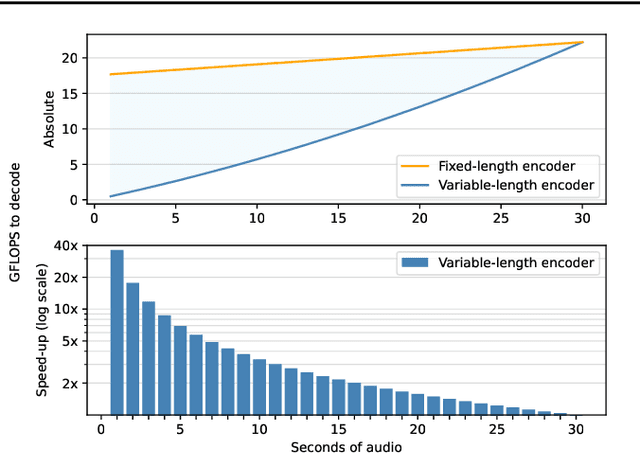


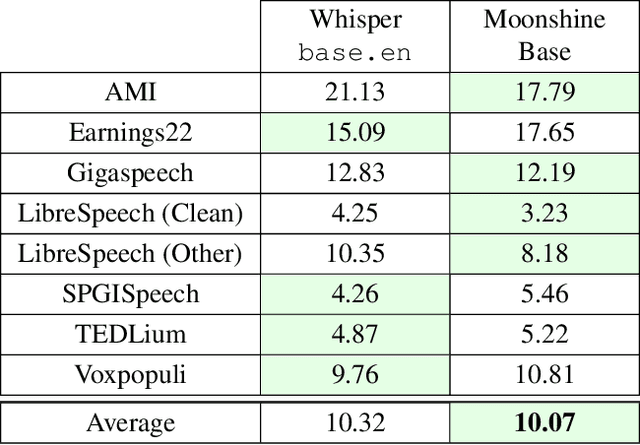
Abstract:This paper introduces Moonshine, a family of speech recognition models optimized for live transcription and voice command processing. Moonshine is based on an encoder-decoder transformer architecture and employs Rotary Position Embedding (RoPE) instead of traditional absolute position embeddings. The model is trained on speech segments of various lengths, but without using zero-padding, leading to greater efficiency for the encoder during inference time. When benchmarked against OpenAI's Whisper tiny.en, Moonshine Tiny demonstrates a 5x reduction in compute requirements for transcribing a 10-second speech segment while incurring no increase in word error rates across standard evaluation datasets. These results highlight Moonshine's potential for real-time and resource-constrained applications.
Wake Vision: A Large-scale, Diverse Dataset and Benchmark Suite for TinyML Person Detection
May 01, 2024

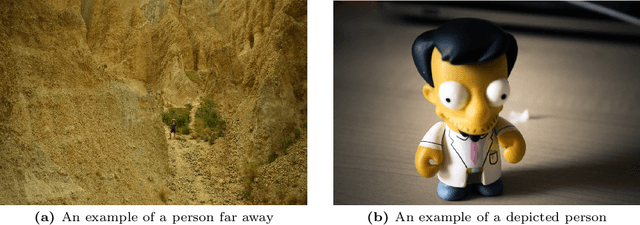

Abstract:Machine learning applications on extremely low-power devices, commonly referred to as tiny machine learning (TinyML), promises a smarter and more connected world. However, the advancement of current TinyML research is hindered by the limited size and quality of pertinent datasets. To address this challenge, we introduce Wake Vision, a large-scale, diverse dataset tailored for person detection -- the canonical task for TinyML visual sensing. Wake Vision comprises over 6 million images, which is a hundredfold increase compared to the previous standard, and has undergone thorough quality filtering. Using Wake Vision for training results in a 2.41\% increase in accuracy compared to the established benchmark. Alongside the dataset, we provide a collection of five detailed benchmark sets that assess model performance on specific segments of the test data, such as varying lighting conditions, distances from the camera, and demographic characteristics of subjects. These novel fine-grained benchmarks facilitate the evaluation of model quality in challenging real-world scenarios that are often ignored when focusing solely on overall accuracy. Through an evaluation of a MobileNetV2 TinyML model on the benchmarks, we show that the input resolution plays a more crucial role than the model width in detecting distant subjects and that the impact of quantization on model robustness is minimal, thanks to the dataset quality. These findings underscore the importance of a detailed evaluation to identify essential factors for model development. The dataset, benchmark suite, code, and models are publicly available under the CC-BY 4.0 license, enabling their use for commercial use cases.
Datasheets for Machine Learning Sensors
Jun 15, 2023Abstract:Machine learning (ML) sensors offer a new paradigm for sensing that enables intelligence at the edge while empowering end-users with greater control of their data. As these ML sensors play a crucial role in the development of intelligent devices, clear documentation of their specifications, functionalities, and limitations is pivotal. This paper introduces a standard datasheet template for ML sensors and discusses its essential components including: the system's hardware, ML model and dataset attributes, end-to-end performance metrics, and environmental impact. We provide an example datasheet for our own ML sensor and discuss each section in detail. We highlight how these datasheets can facilitate better understanding and utilization of sensor data in ML applications, and we provide objective measures upon which system performance can be evaluated and compared. Together, ML sensors and their datasheets provide greater privacy, security, transparency, explainability, auditability, and user-friendliness for ML-enabled embedded systems. We conclude by emphasizing the need for standardization of datasheets across the broader ML community to ensure the responsible and effective use of sensor data.
MLPerf Tiny Benchmark
Jun 28, 2021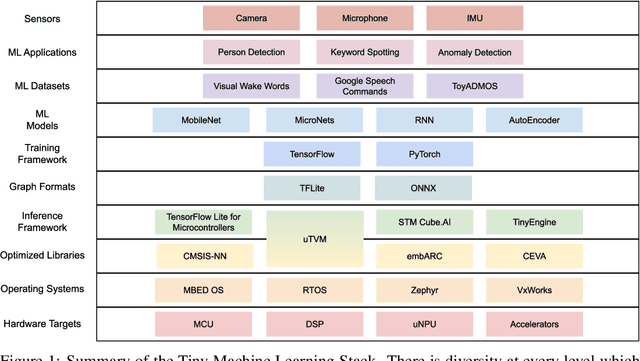
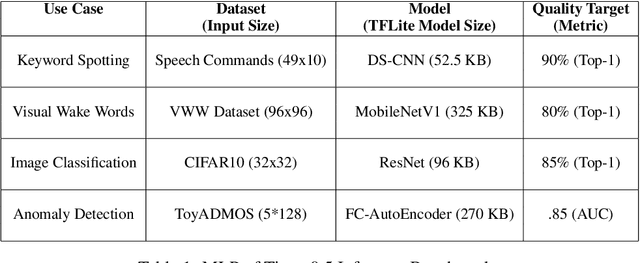
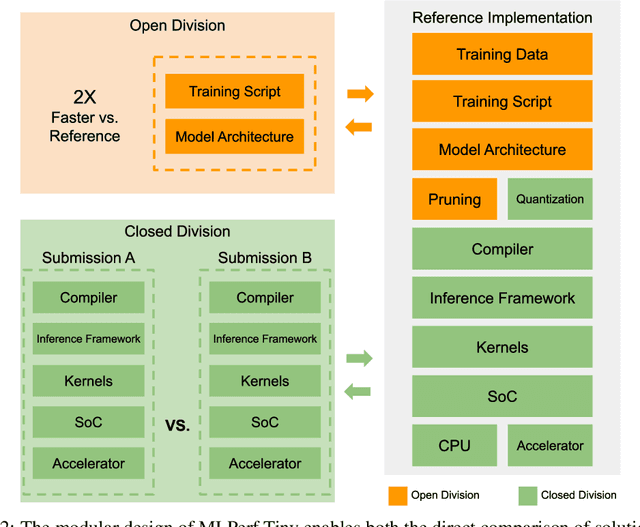
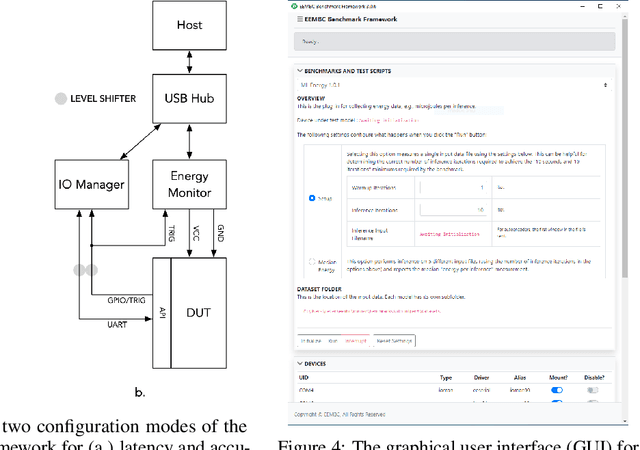
Abstract:Advancements in ultra-low-power tiny machine learning (TinyML) systems promise to unlock an entirely new class of smart applications. However, continued progress is limited by the lack of a widely accepted and easily reproducible benchmark for these systems. To meet this need, we present MLPerf Tiny, the first industry-standard benchmark suite for ultra-low-power tiny machine learning systems. The benchmark suite is the collaborative effort of more than 50 organizations from industry and academia and reflects the needs of the community. MLPerf Tiny measures the accuracy, latency, and energy of machine learning inference to properly evaluate the tradeoffs between systems. Additionally, MLPerf Tiny implements a modular design that enables benchmark submitters to show the benefits of their product, regardless of where it falls on the ML deployment stack, in a fair and reproducible manner. The suite features four benchmarks: keyword spotting, visual wake words, image classification, and anomaly detection.
TensorFlow Lite Micro: Embedded Machine Learning on TinyML Systems
Oct 20, 2020



Abstract:Deep learning inference on embedded devices is a burgeoning field with myriad applications because tiny embedded devices are omnipresent. But we must overcome major challenges before we can benefit from this opportunity. Embedded processors are severely resource constrained. Their nearest mobile counterparts exhibit at least a 100---1,000x difference in compute capability, memory availability, and power consumption. As a result, the machine-learning (ML) models and associated ML inference framework must not only execute efficiently but also operate in a few kilobytes of memory. Also, the embedded devices' ecosystem is heavily fragmented. To maximize efficiency, system vendors often omit many features that commonly appear in mainstream systems, including dynamic memory allocation and virtual memory, that allow for cross-platform interoperability. The hardware comes in many flavors (e.g., instruction-set architecture and FPU support, or lack thereof). We introduce TensorFlow Lite Micro (TF Micro), an open-source ML inference framework for running deep-learning models on embedded systems. TF Micro tackles the efficiency requirements imposed by embedded-system resource constraints and the fragmentation challenges that make cross-platform interoperability nearly impossible. The framework adopts a unique interpreter-based approach that provides flexibility while overcoming these challenges. This paper explains the design decisions behind TF Micro and describes its implementation details. Also, we present an evaluation to demonstrate its low resource requirement and minimal run-time performance overhead.
 Add to Chrome
Add to Chrome Add to Firefox
Add to Firefox Add to Edge
Add to Edge